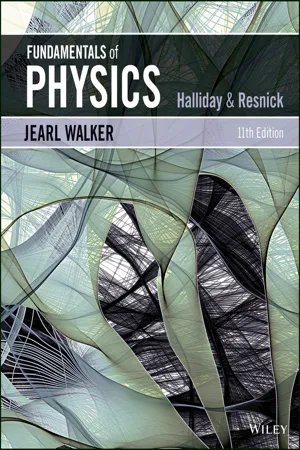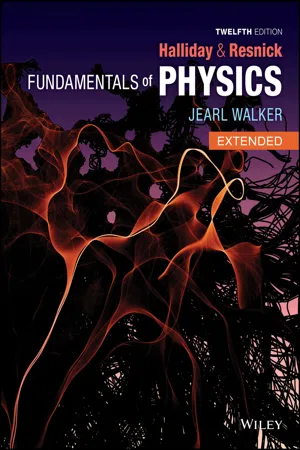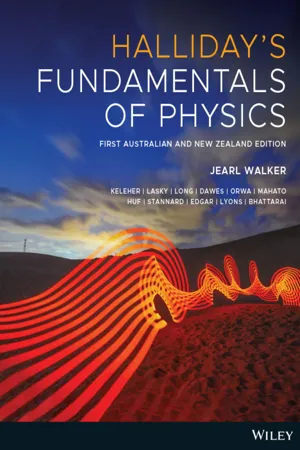Physics
Potential Energy
Potential energy is the stored energy an object has due to its position or state. It is the energy that an object possesses because of its potential to do work. The amount of potential energy an object has depends on its mass, height, and the force acting on it.
Written by Perlego with AI-assistance
Related key terms
1 of 5
6 Key excerpts on "Potential Energy"
- eBook - PDF
- David Halliday, Robert Resnick, Jearl Walker(Authors)
- 2018(Publication Date)
- Wiley(Publisher)
What Is Physics? One job of physics is to identify the different types of energy in the world, especially those that are of common importance. One general type of energy is Potential Energy U. Technically, Potential Energy is energy that can be associated with the configuration (arrangement) of a system of objects that exert forces on one another. C H A P T E R 8 Potential Energy and Conservation of Energy 8-1 Potential Energy Learning Objectives After reading this module, you should be able to . . . ● A force is a conservative force if the net work it does on a particle moving around any closed path, from an initial point and then back to that point, is zero. Equivalently, a force is conservative if the net work it does on a particle moving between two points does not depend on the path taken by the particle. The gravitational force and the spring force are conservative forces; the kinetic frictional force is a nonconservative force. ● Potential Energy is energy that is associated with the configuration of a system in which a conservative force acts. When the conservative force does work W on a particle within the system, the change ∆U in the Potential Energy of the system is ∆U = −W. If the particle moves from point x i to point x f , the change in the Potential Energy of the system is ΔU = − ∫ x f x i F(x) dx. ● The Potential Energy associated with a system consist- ing of Earth and a nearby particle is gravitational Potential Energy. If the particle moves from height y i to height y f , the change in the gravitational Potential Energy of the particle–Earth system is ∆U = mg( y f − y i ) = mg ∆y. ● If the reference point of the particle is set as y i = 0 and the corresponding gravitational Potential Energy of the system is set as U i = 0, then the gravitational Potential Energy U when the particle is at any height y is U( y) = mgy. ● Elastic Potential Energy is the energy associated with the state of compression or extension of an elastic object. - eBook - PDF
- David Halliday, Robert Resnick, Jearl Walker(Authors)
- 2020(Publication Date)
- Wiley(Publisher)
150 What Is Physics? One job of physics is to identify the different types of energy in the world, especially those that are of common importance. One general type of energy is Potential Energy U. Technically, Potential Energy is energy that can be associated with the configuration (arrangement) of a system of objects that exert forces on one another. C H A P T E R 8 Potential Energy and Conservation of Energy 8-1 Potential Energy Learning Objectives After reading this module, you should be able to . . . ● A force is a conservative force if the net work it does on a particle moving around any closed path, from an initial point and then back to that point, is zero. Equivalently, a force is conservative if the net work it does on a particle moving between two points does not depend on the path taken by the particle. The gravitational force and the spring force are conservative forces; the kinetic frictional force is a nonconservative force. ● Potential Energy is energy that is associated with the configuration of a system in which a conservative force acts. When the conservative force does work W on a particle within the system, the change ∆U in the Potential Energy of the system is ∆U = −W. If the particle moves from point x i to point x f , the change in the Potential Energy of the system is ΔU = − ∫ x f x i F(x) dx. ● The Potential Energy associated with a system consist- ing of Earth and a nearby particle is gravitational Potential Energy. If the particle moves from height y i to height y f , the change in the gravitational Potential Energy of the particle–Earth system is ∆U = mg( y f − y i ) = mg ∆y. ● If the reference point of the particle is set as y i = 0 and the corresponding gravitational Potential Energy of the system is set as U i = 0, then the gravitational Potential Energy U when the particle is at any height y is U( y) = mgy. ● Elastic Potential Energy is the energy associated with the state of compression or extension of an elastic object. - eBook - PDF
- David Halliday, Robert Resnick, Jearl Walker(Authors)
- 2021(Publication Date)
- Wiley(Publisher)
(8.1.7) If the reference point of the particle is set as y i = 0 and the cor- responding gravitational Potential Energy of the system is set as U i = 0, then the gravitational Potential Energy U when the par- ticle is at any height y is U( y) = mgy. (8.1.9) Elastic Potential Energy Elastic Potential Energy is the energy associated with the state of compression or extension of an elastic object. For a spring that exerts a spring force F = −kx when its free end has displacement x, the elastic Potential Energy is U(x) = 1 _ 2 kx 2 . (8.1.11) Additional examples, video, and practice available at WileyPLUS 210 CHAPTER 8 Potential Energy AND CONSERVATION OF ENERGY is not involved, the work done on the system and the change ∆E mec in the mechanical energy of the system are equal: W = ∆E mec = ∆K + ∆U. (8.4.1, 8.4.2) When a kinetic frictional force acts within the system, then the thermal energy E th of the system changes. (This energy is asso- ciated with the random motion of atoms and molecules in the system.) The work done on the system is then W = ∆E mec + ∆E th . (8.4.9) The change ∆E th is related to the magnitude f k of the frictional force and the magnitude d of the displacement caused by the external force by ∆E th = f k d. (8.4.7) Conservation of Energy The total energy E of a system (the sum of its mechanical energy and its internal energies, including thermal energy) can change only by amounts of energy that are transferred to or from the system. This experimental fact is known as the law of conservation of energy. If work W is done on the system, then W = ∆E = ∆E mec + ∆E th + ∆E int . (8.5.1) If the system is isolated (W = 0), this gives ∆E mec + ∆E th + ∆E int = 0 (8.5.2) and E mec,2 = E mec,1 − ∆E th − ∆E int , (8.5.3) where the subscripts 1 and 2 refer to two different instants. Power The power due to a force is the rate at which that force transfers energy. - eBook - PDF
- John D. Cutnell, Kenneth W. Johnson, David Young, Shane Stadler(Authors)
- 2018(Publication Date)
- Wiley(Publisher)
LEARNING OBJECTIVES After reading this module, you should be able to... 19.1 Define electrical Potential Energy. 19.2 Solve problems involving electric potential and electric Potential Energy. 19.3 Calculate electric potential created by point charges. 19.4 Relate equipotential surfaces to the electric field. 19.5 Solve problems involving capacitors. 19.6 Describe biomedical applications of electric potential. DANIEL MIHAILESCU/AFP/Getty Images/NewsCom CHAPTER 19 Electric Potential Energy and the Electric Potential In the medical diagnostic technique of electroencephalography, electrodes placed at various points on the head detect the small voltages that exist between the points. The cap worn by the young man in this photograph facilitates the placement of a number of electrodes, so that the voltages created by different regions of the brain as he plays a flipper pinball game can be measured simultaneously. The voltage between two points is another name for the difference in electric potential between the points, which is related to the concept of electric Potential Energy. Electric Potential Energy and electric potential are the central ideas in this chapter. 19.1 Potential Energy In Chapter 18 we discussed the electrostatic force that two point charges exert on each other, the magnitude of which is F = k|q 1 ||q 2 |/r 2 . The form of this equation is similar to the form for the gravitational force that two particles exert on each other, which is F = Gm 1 m 2 /r 2 , according to Newton’s law of universal gravitation (see Section 4.7). Both of these forces are conservative and, as Section 6.4 explains, a Potential Energy can be asso- ciated with a conservative force. Thus, an electric Potential Energy exists that is analogous to the gravitational Potential Energy. To set the stage for a discussion of the electric poten- tial energy, let’s review some of the important aspects of the gravitational counterpart. - eBook - PDF
- John D. Cutnell, Kenneth W. Johnson, David Young, Shane Stadler(Authors)
- 2015(Publication Date)
- Wiley(Publisher)
The word “volt” also appears in another context, as part of a unit that is used to measure energy, particularly the energy of an atomic particle, such as an electron or a proton. This energy unit is called the electron volt (eV). One electron volt is the magnitude of the amount by which the Potential Energy of an electron changes when the electron moves through a potential difference of one volt. Since the magnitude of the change in Potential Energy is uq 0 DVu 5 u(21.60 3 10 219 C) 3 (1.00 V)u 5 1.60 3 10 219 J, it follows that 1 eV 5 1.60 3 10 219 J One million (10 16 ) electron volts of energy is referred to as one MeV, and one billion (10 19 ) electron volts of energy is one GeV, where the “G” stands for the prefix “giga” (pronounced “jig9a”). In Equation 19.3, we have seen that the electric potential is the electric Potential Energy per unit charge. In previous chapters, we have seen that the total energy of an object, which is the sum of its kinetic and potential energies, is an important concept. Its significance lies in the fact that the total energy remains the same (is conserved) during the object’s motion, provided that nonconservative forces, such as friction, are either absent or do no net work. While the sum of the energies at each instant remains constant, energy may be converted from one form to another; for example, gravitational Potential Energy is converted into kinetic energy as a ball falls. We now include the electric Potential Energy EPE as part of the total energy that an object can have: E 5 1 2 m v 2 1 1 2 Iv 2 1 mgh 1 1 2 kx 2 1 EPE e Total energy e Translational kinetic energy e Rotational kinetic energy e Gravitational Potential Energy e Elastic Potential Energy e Electric Potential Energy If the total energy is conserved as the object moves, then its final energy E f is equal to its initial energy E 0 , or E f 5 E 0 . Example 4 illustrates how the conservation of energy is applied to a charge moving in an electric field. - David Halliday, Jearl Walker, Patrick Keleher, Paul Lasky, John Long, Judith Dawes, Julius Orwa, Ajay Mahato, Peter Huf, Warren Stannard, Amanda Edgar, Liam Lyons, Dipesh Bhattarai(Authors)
- 2020(Publication Date)
- Wiley(Publisher)
• If the reference point of the particle is set as y i = 0 and the corresponding gravitational Potential Energy of the system is set as U i = 0, then the gravitational Potential Energy U when the particle is at any height y is U (y) = mgy. • Elastic Potential Energy is the energy associated with the state of compression or extension of an elastic object. For a spring that exerts a spring force F = −kx when its free end has displacement x, the elastic Potential Energy is U (x) = 1 2 kx 2 . • The reference configuration has the spring at its relaxed length, at which x = 0 and U = 0. Why study physics? Whether climbing the 134-metre-high top arch of Sydney Harbour Bridge or enjoying the 43-metre adrenaline-fuelled bungy jump at Kawarau Gorge Suspension Bridge in Queenstown, you are experiencing a change in your Potential Energy and conservation of energy. 1 Work and Potential Energy FIGURE 8.1 A tomato is thrown upward. As it rises, the gravitational force does negative work on it, decreasing its kinetic energy. As the tomato descends, the gravitational force does positive work on it, increasing its kinetic energy. Negative work done by the gravitational force Positive work done by the gravitational force In chapter 7 we discussed the relation between work and a change in kinetic energy. Here we discuss the relation between work and a change in Potential Energy. Let us throw a tomato upward. We already know that as the tomato rises, the work W g done on the tomato by the gravitational force is negative because the force transfers energy from the kinetic energy of the tomato (figure 8.1). We can now finish the story by saying that this energy is transferred by the gravitational force to the gravitational Potential Energy of the tomato–Earth system. The tomato slows, stops, and then begins to fall back down because of the gravitational force.
Index pages curate the most relevant extracts from our library of academic textbooks. They’ve been created using an in-house natural language model (NLM), each adding context and meaning to key research topics.





